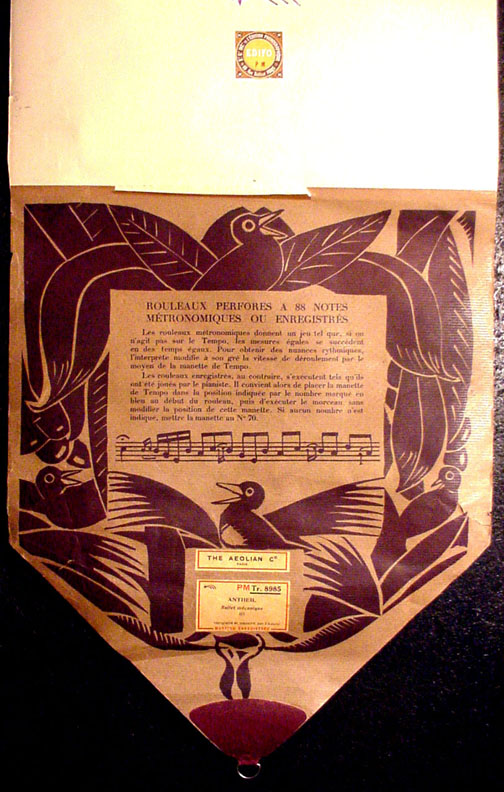
Here's a music roll leader which few people have seen, the one for BALLET MECANIQUE as sold in France, originally by the Pleyel Piano Co. (which first published it during the period of their "Pleyela" pneumatic players). The Pleyel roll duplicating business apparently taken over by The Aeolian Co. of Paris after 1927. [Pleyel continued to offer the rolls, possibly perforated by Aeolian after that time, until the early 'Fifties, when their factory was being razed.] For the ARTCRAFT arrangement, shown in the previous Internet pages, Rolls I and II were 'read' by the Leabarjan #8-B (scroll down to the bottom photograph) which had access to Pleyel-made copies of 1925. The illustration below is one of the Aeolian-Pleyel rolls, but musically the errors, omissions and faulty striking effects remain the same between the 2 series. Both BALLET MECANIQUE releases obviously shared identical Masters.
One visual difference between the earlier Pleyel rolls and the Aeolian-Pleyel example shown here is that the former just had white leaders with conventional labels, while French Aeolian attached an Art Deco leader with stylized 'bird' motifs. The French text explains the differences between ARRANGED and HAND-PLAYED Rolls, showing that baloney in this field was served up equally on both sides of the Atlantic. When playing the HAND-PLAYED roll (which BALLET MECANIQUE could never be in music roll form!) one is told to set the Tempo Lever at "70" and that all the phrasing nuances will be automatically registered by the player action. Fooey! Just beyond this leader appears Tempo "85" which the roll states should be maintained until the end. Fine, but to keep this 8½ feet-per-minute tempo running, the Pianolist must readjust the settings frequently. This means that the performer will make use of the Tempo Lever after all.
Paper build-up on the lower spool affects the tempo,
which is one of the reasons why any player should never be performing
unattended!
